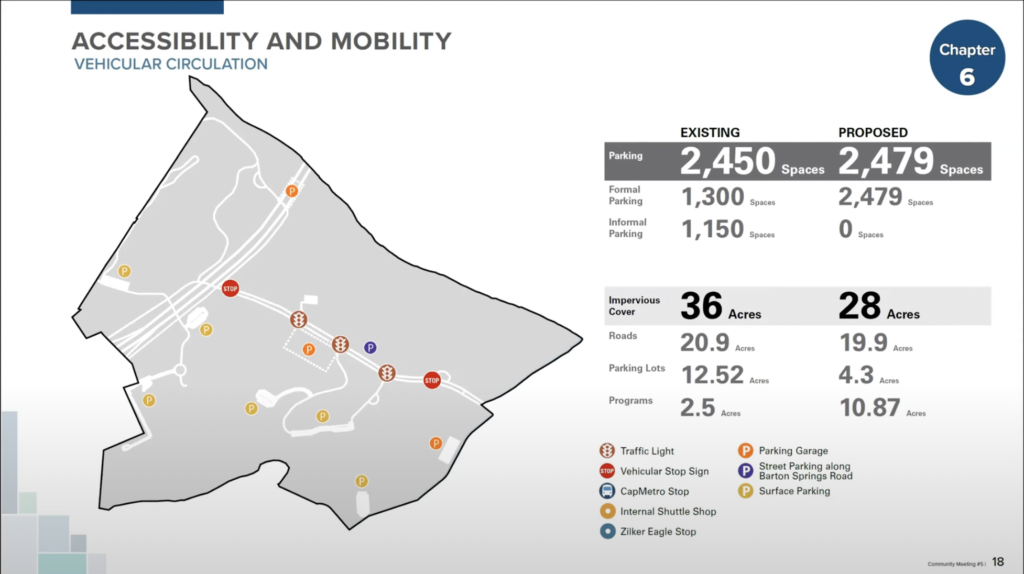Zilker Park plan brings worries over parking, ecology, athletic fields
Monday, December 12, 2022 by
Chad Swiatecki Concerns about athletic fields, ecological impacts, and plans for major accessibility and transportation infrastructure were among the issues discussed during a recent feedback session with planners working on the future of Zilker Park.
Last month the city unveiled its draft vision plan for the 351-acre park, with stated goals including improving and rehabilitating areas of environmental distress as well as making the city’s major metropolitan park more welcoming and open to visitors from throughout the area.
Last week there were two input sessions on the plan, with an online virtual forum followed by an in-person information and roundtable event.
After the draft plan was revealed there was substantial discussion and criticism on social media sites about aspects of the plan, which is still in the early conceptual phase and will be revised based on community discussion. Some of the most pointed concerns focused on three proposed parking decks that would be located on the perimeter of the park, with substantial underground parking included.
Forum organizers and presenters noted during the talk that the 2,500 proposed spaces is roughly equal to the current formal and informal parking on-site, and that the parking structures could reduce the footprint of current parking needs while bringing up to eight acres of land back into use for parkland.
Claire Hempel, principal with consulting firm Design Workshop, said the reconfigured parking and eventual construction of transit routes around the park would better serve visitors who don’t live within the Zilker neighborhood.
“It is critical to serve people driving to the park, to serve the entire community of Austin, spanning from far Northeast Austin in Williamson County in some parts down to District 8 where you’re in Hayes County, so we need to have parking solutions at least until frequent realistic transportation options can catch up to the plan.”
Responding to a question about the possible use of nearby private parking, she said there are complications that make those options difficult to manage.
“We started off mapping out all of the existing parking, at least structured parking, in a decent walking radius from the park and there’s a lot. The trick is complicated management structures with privately owned garages, insurance and liability,” she said. “The bright side of this is third-party platforms are working to eliminate the contracting insurance the city would have to work through … the city has a lot of other things going on and we want to be able to have a platform where people could find parking outside of the park but within walking distance of where they want to go.”

Part of the plan presented at last week’s meeting.
Many questions remain about the timetable and financing model for the ambitious plan, with the city’s General Fund covering the $6.1 million annual cost of maintaining and operating the park. Consultant Charlie McCabe noted that nonprofit conservancies and philanthropists are responsible for much of the park’s upkeep, with a balance of public money and donations needed to fulfill the plan.
“There’s the matter of how do we achieve that balance between this kind of metropolitan city use with ecological and environmental set of challenges within the park? And how do we balance the fact that everything costs money?” he said. “Not only are capital projects expensive, but just maintaining the park in light of the usage is very expensive as well.”
Other frequent discussion topics included the plan to reduce Barton Springs Road to two lanes to lessen vehicular effects for park visitors, and the impact of Austin City Limits Festival on the park and how much money the city receives from promoter C3 Presents for its use.
Several public commenters expressed worry about the possibility that the park’s 18-hole disc golf course would lose many of its holes or be negatively reconfigured. One participant noted, “If you look at how many disc golf courses are within five, 10 or 20 miles of Zilker Park and compare that with how many basketball, baseball fields or other sport fields are within the same areas you’ll see that there’s a large disparity. It’s not right to replace a historic location like the disc golf course at Zilker Park with fields that could be placed somewhere else and have less impact on the tree population in that area.”
Photo made available through a Creative Commons license.
The Austin Monitor’s work is made possible by donations from the community. Though our reporting covers donors from time to time, we are careful to keep business and editorial efforts separate while maintaining transparency. A complete list of donors is available here, and our code of ethics is explained here.
You're a community leader
And we’re honored you look to us for serious, in-depth news. You know a strong community needs local and dedicated watchdog reporting. We’re here for you and that won’t change. Now will you take the powerful next step and support our nonprofit news organization?








